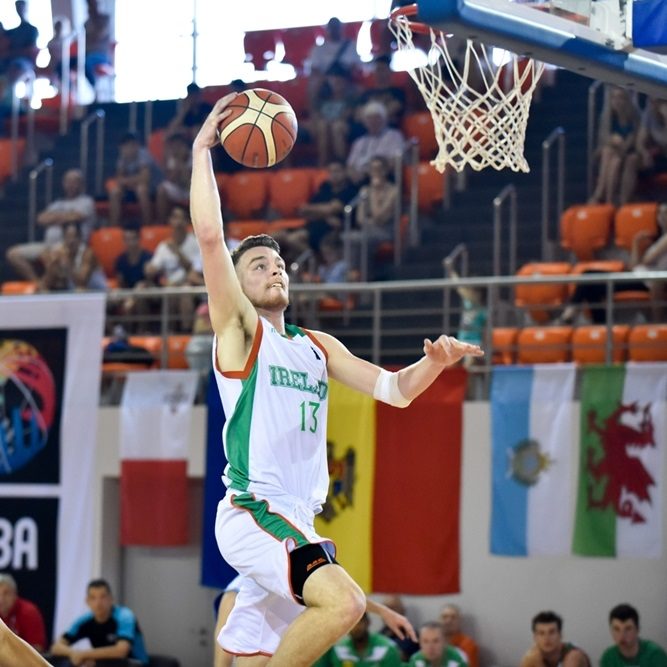
Irish basketball made it’s comeback last week at the FIBA European Small Countries Championships, now Emmet Ryan says the questions are what the next steps will be
There was a lot to take in last week. Huge highs came early for both teams before deflating finishes were followed by a realisation of what this is really all about.
The Irish men blitzed Gibraltar and Malta before eventually getting a test from San Marino in the group stages. Then came Bryant Dunston and Andre Spight to spoil their dreams and guide Armenia to the final, eventually resulting in gold. That was followed by a clear cut defeat to San Marino in the bronze medal game.
The women started in similar fashion, sweeping aside Wales and Moldova in the group stage before comfortably getting past Andorra to book a spot in the final with Malta. At the half, it looked like it would be a sweep of easy wins for the Irish women but a big time comeback from the Maltese meant that once more Ireland had to settle for silver, their fourth in four trips to the competition.
The realities of the challenge ahead were given a lot more clarity at those tournaments in Gibraltar and Moldova. Armenia, like so many European nations, have the budget to bring in an import like Dunston. Ireland? The federation had to run fundraisers to send teams. That’s a massive difference at the senior level and one that is going to give time for thought with how to manage the return to the top tier.
FIBA’s plans for reforming the qualification process, which are already in place with women’s tournaments, come into play for the men with the qualifiers for the next World Cup.
Ireland won’t make it to China 2019 but the question is whether it wants to try to be part of the process
With the women, based on the cycles of qualification, returning directly to the European Small Countries in 2018 looks the practical option and it would be particularly surprising if they don’t. With the men, the option is theoretically still open to enter Division B and in turn make it part of the cycle towards EuroBasket 2021.
If this is already starting to sound a touch complex, congratulations you are starting to see the broader picture. FIBA’s decision to essentially restore the Division A and B formats in Europe will ensure we avoid some of the more horrific mismatches of that could occur if, say, Spain played Gibraltar. It also means a bit more of a staggered route between the tiers of European hoops, something that became less manageable following the expansion of EuroBasket from 16 to 24 teams. Essentially international hoops jumped from Division A to Division C and that naturally proved off-putting to the teams at the upper echelon of C and the lower end of A.
The flip side is that staggering also puts obvious ceilings in place. One thing football gets right is that at the start of every cycle, there’s the democratic opportunity for everyone to go after the biggest prize. It may not be plausible but the chance of even dreaming of a giant killing is important and minnows live off hope. Those minnows don’t just give a story to their own people when they succeed, they spur on those giving up their time elsewhere to emulate them. The sport as a whole benefits from minnows.
Basketball doesn’t seem too keen on that approach with a multi-stage qualification tournament essentially making it impractical for a Spain vs Gibraltar type of clash to occur. From Ireland’s perspective that’s an awful lot to chew on as the appeal of going back into the international fold is the chance to see the best in the business come to these shores, raising the profile of the game and subsequently making the sport more sponsor friendly.
Now were this site running the show the idea of retaining a C grade contest while opening up the broader qualification process to all might seem like small sides getting preferential treatment but the broader purpose would be to give developing nations a leg up so they can aim to move out of the C grade on a long-term basis. It would also show basketball being a touch more visionary than football.
Back on topic, all of these complexities make the likely outcome of the whole scenario be Ireland opting once more to go for the Small Countries route again in 2018 and 2020. Locking in to that, subsequently entering the 2023 cycle (where Ireland would move into Division B) seems the most natural route. With the women, that might prove a touch more complicated as EuroBasket for Women and the Women’s World Cup have not adjusted their schedules in quite the same way as the men’s versions.
Continuing at Small Countries level for 2018 looks like it can be managed without a challenge for the women and a bid to host one or both of the tournaments over the next couple of cycles has to be at least being considered.
One thing seems a near certainty, there won’t be an Irish side in the FIBA Europe Cup next season. While a fine experience for Irish hoops, without a long-term plan in place to pursue and develop in the competition continued participation beyond the experimentation stage seems hard to justify and the word around Irish basketball seems to be a desire to put those resources (human not just financial) into the national teams proper.
The big question is summer 2017, with EuroBasket taking up the attentions of the top 24 national teams on the continent. What can Irish basketball do to take some advantage of the warm up cycle. Few, if any, qualified teams will want to have anything to do with Irish sides but for the women and men’s sides it’s a legitimate opportunity to have home internationals for the first time in an awfully long time.
With Cork’s Mardyke and the arena in Dublin natural venues, running four team tournaments for each next summer seems an obvious goal to set. You get to bring your best players together in one location and attract a national focus. The goal would have to be on ensuring the events were actually profitable but, when you go beyond that, a whole bunch of other questions occur. So many that there will be sore heads in Basketball Ireland offices if they so much as look at taking on the challenge a year from now. It’s a headache worth earning. Ireland’s back, now the challenge is to make sure it doesn’t disappear again.







Leave a Reply